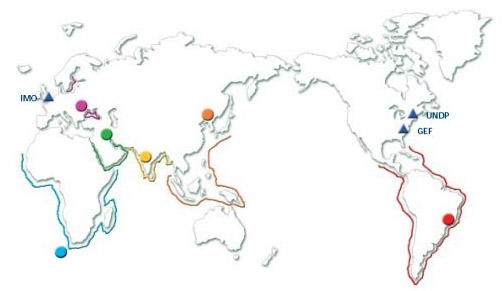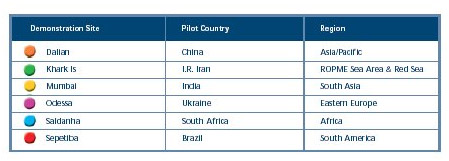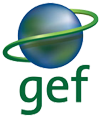The Project > The GloBallast pilot phase 2000-2004
In the year 2000, IMO joined forces with the Global Environment Facility (GEF), the United Nations Development Programme (UNDP), member governments and the shipping industry to assist less-industrialised countries to tackle the ballast water problem.
The full title of this project was Removal of Barriers to the Effective Implementation of Ballast Water Control and Management Measures in Developing Countries. It was more simply referred to as the Global Ballast Water Management Programme, or GloBallast.
Demonstration Sites
This programme assisted developing countries to implement effective measures to control the introduction of foreign marine species. These were intended to represent the six main developing regions of the World, as shown on the map below:



Demonstration Site Contacts
As these sites were so successful, they have since been replicated throughout each region. Lessons learned from the initial demonstration sites have been valuable in improving ballast water management and reducing the translocation of harmful marine species in each region.
The programme provided a mechanism for the ongoing provision of technical assistance to less industrialised countries to implement the new IMO ballast water regime when it comes into force, through the continuation of an in-house ballast water unit at IMO. This has built on the groundwork conducted by the first-phase Programme Coordination Unit.
Development Objectives
The broad Development Objectives of the programme were to assist developing countries to:
- reduce the transfer of harmful organisms from ships’ ballast water;
- implement the IMO ballast water guidelines; and
- prepare for implementation of the newly adopted IMO Ballast Water Convention.
Immediate Objectives
In order to achieve the broad Development Objectives, the programme had a number of Immediate Objectives, which were linked to specific Outputs and Activities. These were:
- Programme coordination and management.
- Communication, education and awareness.
- Risk assessment
- Ballast water management measures.
- Compliance, enforcement and monitoring.
- Regional cooperation and replication.
- Resources and financing.
An extremely important consideration was to ensure coordination between each site and consistency with the international regime. As shipping is an international industry, the only effective way to address shipping related issues is through a standardised international system. This has been one of the hallmarks of the success of IMO in its 50 year history. The avoidance of unilateral responses by individual states was critical to the success of the programme.
Timeline and Funding
This was a four-year programme (initially three years from March 2000 to March 2003, with an extension to December 2004). The total budget was US$10.2 million, comprising: US$7.39 million from GEF and US$2.8 million in co-funding from the six Pilot Countries.
Programme Management
The programme was implemented by UNDP and executed by IMO, under the GEF International Waters portfolio.
A three person Programme Coordination Unit (PCU) was established within the Marine Environment Division (MED) at IMO headquarters in London.
The PCU had the benefit of the support, facilities and services of IMO. High priority was given to coordinating the activities of the programme with the broader activities of IMO, especially the adoption of the new Ballast Water Convention.
Country Focal Points (CFPs) and Assistant CFPs were established in each of the six Pilot Countries, supported by inter-ministerial/cross-sectoral Country Project Task Forces (CPTFs).
Overall, the programme was advised by a Global Project Task Force (GPTF). This was comprised of representatives of GEF, UNDP, IMO, the six participating countries, the shipping industry, international environmental NGOs and possible other parties that were able to contribute to the programme in a meaningful way.
Programme Summary
Development objectives
Timeline – Four years: March 2000 – March 2003 (with an extension to 31 December 2004)
Initial funding – US$7.4 million from Global Environment Facility (GEF). US$2.8 million support-in-kind from participating countries.
Implementation – United Nations Development Programme (UNDP)
Execution – International Maritime Organization (IMO) Programme Coordination Unit (PCU).
Recipients/beneficiaries – Initially, six Pilot Countries/demonstration sites, to be replicated throughout the regions.
Partners – Shipping and port industries, international environmental non-government organization, other parties as programme develops.
Activities to be undertaken
- Establish PCU at IMO, comprising Chief Technical Adviser, Technical Advisers, Programme Assistant and support.
- Establish Info/Comms Network – including web-site, databases/directories, library collections, newsletter and an information clearing house.
- Establish and support Lead Agency, Country Focal Point (CFP), Country Project Task Force (CPTF) and CFP Assistant in each Pilot Country.
- Establish global coordination arrangements – Global Project Task Force.
- Develop and implement communication, education and awareness raising programmes.
- Undertake Ballast Water Risk Assessments to assess risk of introductions of marine species at each demonstration site.
- Undertake Port Baseline Surveys of native biota and introduced marine species at each demonstration site.
- Develop Training Packages to train Lead Agency, port and shipping personnel in ballast water management measures as contained in IMO guidelines.
- Review legislation relevant to ballast water in each country and advise/assist improvements.
- Develop and implement national ballast water management plans for each Pilot Country.
- Hold global R&D symposiums to review scope for new ballast water management and treatment measures and coordinate R&D agenda.
- Develop Compliance Monitoring and Enforcement (CME) systems for each demonstration site, including ballast water sampling equipment and training.
- Form Regional Task Force (RTF’s), support RTF meetings and study tours to the demonstration sites by personnel from neighbouring countries.
- Identify long term economic instruments that can be used to resource in country ballast water management arrangements.
- Hold a Strategic Directions/Global Donor Conference to identify and secure donors for subsequent phase of the programme.






